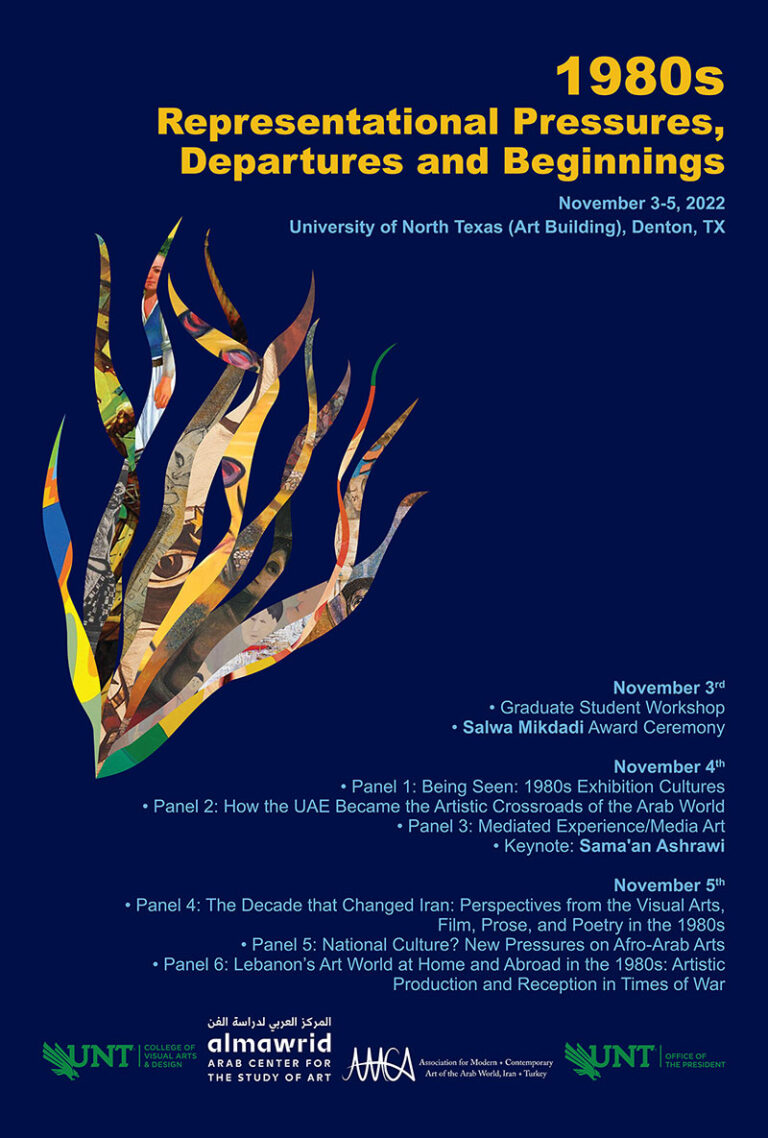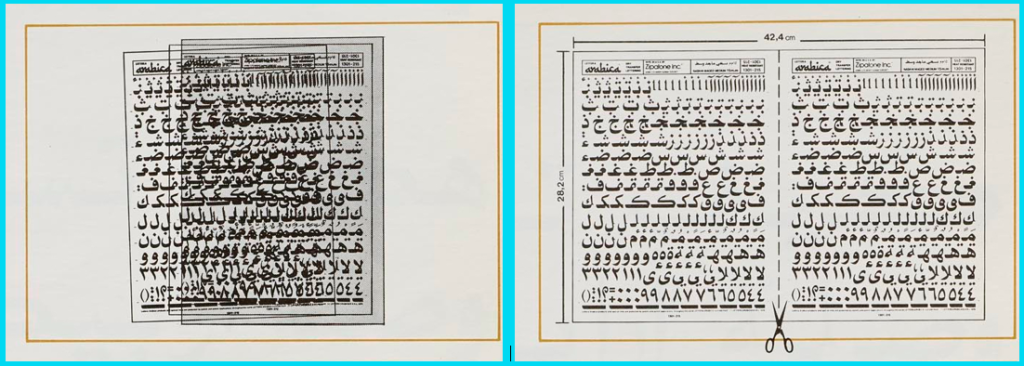1980s: Representational Pressures, Departures, and Beginnings
November 3-5, 2022 ** in person **
University of North Texas, Denton, TX (all times are in CST)

Organizational Sponsors: Office of the President and Department of Art History, University of North Texas; al Mawrid Arab Center for the Study of Art, NYU Abu Dhabi; Association for Modern and Contemporary Art of the Arab World, Iran, and Turkey (AMCA).
Conference Committee: Nada Shabout, Salwa Mikdadi, Sarah Rogers, Anneka Lenssen, Pamela Karimi, and Jessica Gerschultz
The 1980s may have reached a conclusion more than thirty years ago, but the decade’s transformations remain active in artistic practice across the countries and communities of what we now call the SWANA region (including, but not limited to, the Arab East, North Africa, Iran, and Turkey). Thanks to consumer recording technologies, experience and memory took new forms–replay and discontinuous viewing–while cultural criticism began to migrate away from the printed page. To look back on the 1980s is not to be nostalgic so much as to confront the very status of beginnings, departures, and ends. The decade features a list of political crises, invasions, occupations, uprisings, forced displacement, coups, emergent surveillance tactics, militias, and hostages, including the grim events of a catastrophic war between Iraq and Iran, that structure narratives about friendship, solidarity, and loss. And, although the 1980s brought rising enthusiasm for contemporary art as a global phenomenon, artists from the region faced a wave of anti-Middle East sentiment that coded their work as resistant or belated. Still other transitions, such as those associated with economic “opening,” came to manifest as intense attachments to things. We see 1980s-era commodities come to double as talismans for artists: a very specific paper shredder known as the Schleicher Intimus 007S; the certain cut of a leather jacket preferred by Cairo taxi drivers; a textile collage featuring doubled Jesus figure on leopard print; Doc Martens tied to a performer’s ankles in Brixton; a Nowruz variety show distributed only on videotape.[1] For every promotion of an idealized fusion of “tradition” and “contemporaneity” issued by a cultural ministry, there have been artists expressing changeable gendered and classed positions in their projects.
Few histories of modern art from the Arab East, North Africa, Iran, and Turkey have devoted attention to the 1980s apart from marking its transitional status.[2] With this conference, we seek to redress the absence. To borrow from Edward Said writing in 1982, what actual affiliations existed between the world of ideas (or images) and the world of brute politics, corporate and state power, and military force?[3] What are the stakes of specific, situated choices by artists, artist groups, promoters/consumers, or curators and collectors? What strategies are formulated, values mobilized, and expressions codified—by whom, and for whom? How to understand the impact of new initiatives, groups, galleries, and institutions, many established by women? What might we learn from this decade, and, conversely, what of its legacy should be jettisoned for the future?
Events concurrent with the conference will include: 1) ceremony to announce the inaugural Salwa Mikdadi Research Travel Grant launched by AMCA, 2) a funded graduate student workshop convened by AMCA, 3) an exhibition in University of North Texas’s CVAD Galleries, “A banquet for Seaweed: Snapshots from the Arab 1980s,” curated by Nada Shabout with loans from the Barjeel Art Foundation and other private collections.
[1] In order, items mentioned or used by artists Gelare Khoshgozaran, Hassan Khan, Gülsün Karamustafa, Mona Hatoum, and Media Farzin.
[2] One exception may be studies of contemporary art in Turkey and their questions around periodization. See the curatorial project of Merve Elveren for SALT, “How did we get here. Turkey in the 1980s.”
[3] Edward W. Said, “Opponents, Audiences, Constituencies, and Community,” Critical Inquiry 9 no. 1 (Sept 1982): 1-26.

Thursday, November 3, 2022
10-4pm: Graduate Student Workshop (open to participating graduate students only)
Participants:
Pujan Karambeigi, Columbia University, NY
Natasha Gasparian, Ruskin School of Art, University of Oxford
Özge Karagöz, Northwestern University, Chicago
Leena Sonbuol, University of North Texas
Derya Acuner, IMT School for Advanced Studies, Lucca
Elham Shahsavar Zadeh, York University, Toronto
Ahmed Abdelazim, University of Wisconsin, Madison
Flavia Malusardi, Cà Foscari University of Venice, Italy
6pm: Launch Ceremony and Celebration: Salwa Mikdadi Research Travel Grant
Friday, November 4, 2022
10-12 pm: Being Seen: 1980s Exhibition Cultures
-Defne Kırmızı, Boston University, “Conceptualism Localized: Öncü Türk Sanatından Bir Kesit Exhibition Series in the 1980s Istanbul”
-Joan Grandjean, University of Geneva, “How Two Arab Art Students Started an Artistic Revolution in London”
-Rachel Winter, Eli and Edythe Broad Art Museum at Michigan State University and University of California, Santa Barbara, “Alterity, Alternative Spaces, and Representation in 1980s London”
12-1:30 pm: How the UAE Became the Artistic Crossroads of the Arab World
Organized by al Mawrid Arab Center for the Study of Art, NYU Abu Dhabi
-Ala Younis, al Mawrid Arab Center for the Study of Art, NYU Abu Dhabi, “Majid Magazine: how a publishing project in the 1980s shaped the visual culture of the Arab world”
-Dina Taha, al Mawrid Arab Center for the Study of Art, NYU Abu Dhabi, “Methods of Self-Mediation in Hassan Sharif’s Practice”
-Sophie Kazan, University of Falmouth, Cornwall, UK and University of Leicester, UK, “Artist Pioneers: Exploring the impact of Art by Emirati artists during the 1980s”
3:45-5:30 pm: Mediated Experience / Media Art
-Anna Levett, Oberlin College, “Ibn ‘Arabi in Sausalito: Etel Adnan in the 1980s”
-Hossein Tavazonizadeh, University of Groningen, “Iranian Interiors in the Narrative Cinema of the 1980s: The Construction of the Memory of Pre-1979 Architecture”
-Anneka Lenssen, University of California, Berkeley, “On Hearing / Not Hearing Houria Niati’s No To Torture”
-Dalia Ibraheem, Rutgers University, “Sha’bi Music in Egypt and the Genres Without History”
6 pm: Keynote Lecture
Sama’an Ashrawi: “The life and times of a Palestinian punk-rocker-turned-hip-hopper in New York City”
Saturday, November 5, 2022
10-12:30 pm: The Decade that Changed Iran: Perspectives from the Visual Arts, Film, Prose, and Poetry in the 1980s
-Blake Atwood, American University of Beirut, “Watching Movies at Home in Iran: Videocassettes and Movie Culture in the 1980s Iran.”
-Pamela Karimi, University of Massachusetts, Dartmouth, “Sites Unseen: State Censorship and the Rise of Alternative Art Forms in Post-Revolutionary Iran.”
-Orkideh Behrouzan, University of London, School of Oriental and African Studies (SOAS), “The Psycho-politics of Coming of Age in 1980s Iran: Perspectives from Pop Culture”
-Amir Moosavi, Rutgers University, “Elegies for Destruction and Moments of Silence: Early Aberrations in Sacred Defense Literature.”
-Fatemeh Shams, University of Pennsylvania, “Writing Outside Borders: Trauma and Alienation in 1980s Exile Persian Poetry”
2-3 pm: National Culture? New Pressures on Afro-Arab Arts
-Chahrazad Zahi, Boston University, “Mohammed Kacimi, 1983-2003: Traversées (Crossings)”
-Cynthia Becker, Boston University, “Seven Walls Revisited (1989): Denis Martinez’s Algeria”
3:15-5:15 pm: Lebanon’s Art World at Home and Abroad in the 1980s: Artistic production and reception in times of war
Organized by LAWHA at the Orient-Institut Beirut (OIB)
-Monique Bellan, Orient-Institut Beirut, “Continuity and Beginnings? Reading Lebanon’s 1980s art exhibitions through the press”
-Çiğdem İvren, University of Bamberg, “Off the Mainstream: War motifs and the medium of printmaking”
-Jessica Gerschultz, University of Kansas, “When the Wood is Fragrant, the Bond is Stronger”: Tapestry and Lebanon (late 1970s-1980s)”
-Nadia von Maltzahn, Orient-Institut Beirut, “Fadi Barrage: ‘To think things out in painting’”